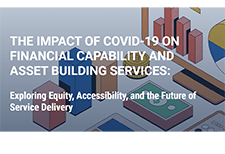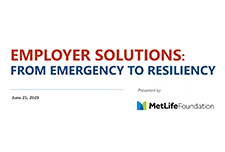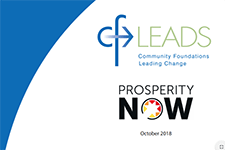Discover financial empowerment resources
Discover financial empowerment resources
The forced transition from in-person to online activities as a result of the COVID-19 pandemic has had a profound impact on how families and communities buy groceries, acquire medical care, and utilize social services. This rapid shift has raised important questions about how to address access and...

To advance understanding of effective financial education methods, the Global Financial Literacy Excellence Center (GFLEC) conducted an experiment using Mint, a financial improvement tool offered by Intuit, whose financial products include TurboTax and QuickBooks. This study measures Mint’s...

In light of COVID-19, the financial security of workers has never been more in question. The workplace is an important delivery channel for tailored financial products and services that can help meet employee’s immediate financial needs and build long-term financial stability. The workplace is a...

This report explores the behaviors and outcomes related to savings and financial well-being of low- and moderate-income (LMI) tax filers in the United States. Findings from research conducted by Prosperity Now, the Social Policy Institute at Washington University in St. Louis and SaverLife...

In this brief, we articulate why collaboration between community foundations and CSA programs is in their mutual interest. We describe the variety of roles that community foundations can play in promoting the growth and success of CSA programs, and then identify the primary challenges encountered...

This is the second in a series of briefs produced by a partnership between the Aspen Institute’s Expanding Prosperity Impact Collaborative (EPIC), Washington University’s Center for Social Development (CSD), and the Intuit Tax and Financial Center. The first brief highlighted new data on the...
In this paper, we examine the relationship between children’s small-dollar savings accounts and college enrollment and graduation. We find that LMI children may be more likely to enroll in and graduate from college when they have small-dollar savings accounts with money designated for school. An...
Over the last decade, initiatives to enhance the financial stability of the economically vulnerable population have multiplied and shown promise. But there is as of yet no strategy on a national scale that addresses the unique consumer financial product and service needs of low-income and...
Family income volatility has increased over the past three decades, though the trend for individual earnings volatility is less clear. Low-income households have more volatile incomes than do higher income households and this gap has grown over time. Job losses, reductions in employment hours, and...
This paper has two main goals. First, we provide a review of 38 studies on the relationship between assets and children’s educational attainment. Second, we discuss implications for Child Development Accounts (CDAs) policies. CDAs have been proposed as a potentially novel and promising asset...
Practitioners engaged in the nascent field of financial development lack a shared system of tracking and analyzing customer progress toward financial security. Practice leaders—ranging from direct service organizations such as the Chicago-based LISC to NeighborWorks America of Washington,...
Financial literacy has been proposed widely as an effective approach to preparing people to manage their finances. This paper proposes an alternative concept, financial capability. Financial capability includes both the ability to act (knowledge, skills, confidence, and motivation) and the...
Current income is usually insufficient to cover college costs in most families, who believe that they must save for college for their children. Furthermore, effects of household savings and asset holding may extend beyond financial security and affect long-term development of children through...
